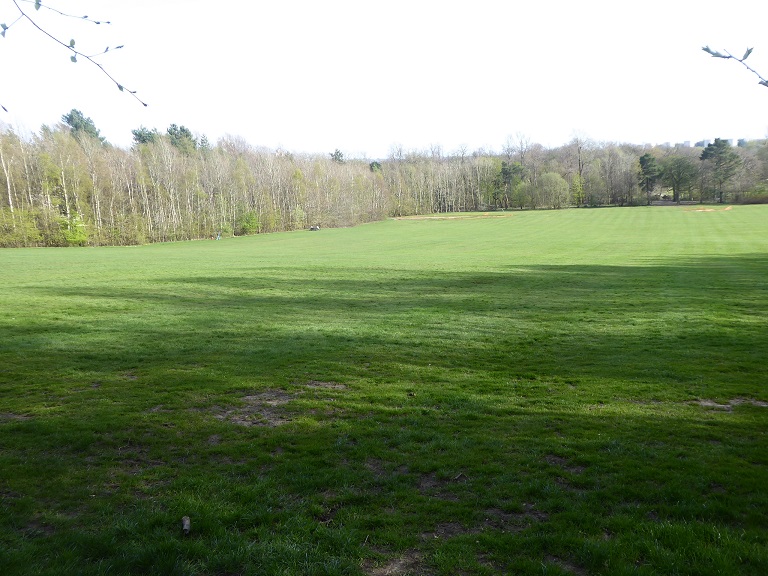
Because perceptions about the risks of Covid-19 vary widely across the population, I think its important to be clear about my own starting point. I write this as someone who is not scared of catching COVID-19, as the risk to fit 60 year olds is very low, but has no wish to do so, or to spread it to other people.
I have, like most of the population, been observing the physical distancing guidance and have managed to do so everywhere except when in the supermarket (ironically the only place I go where there is a legal requirement to keep people 2m apart). I am not too perturbed about that, however, as the science of respiratory viruses suggests that unless you spend 15 minutes in closer physical proximity or the other person coughs or sneezes, the risk of transmission is low. Hence, why the staff in supermarkets are not all off sick – which is not to say that supermarkets couldn’t have done more to protect their staff or to say that I don’t try and minimise the time I spend passing people in supermarket isles.
I have not been in a car or been outwith my part of the southside of Glasgow – mostly Nicola Sturgeon’s constituency – since the Covid-19 “lockdown”, although I know much of the countryside is completely empty and there are plenty of places I could go and be unlikely to see anyone. Instead, I have been running to and around Pollok Park, just over a mile from my home, every day.
This post takes a look at what that experience says about the clampdown by government on outdoor recreation and access during the corona crisis and the Stay at Home message, designed in London for that city.
The new crimes of being outdoors

I have not been in the habit of breaking the law but, since the introduction of the Health Protection (Coronavirus) (Restrictions) (Scotland) Regulations 2020 three weeks ago, have almost certainly been committing criminal offences on an almost daily basis despite observing the 2m physical distancing guidance.
It is important to note here that there is NO provision in the Regulations requiring people when going out to keep 2m distance from people who don’t live in their household. That is guidance, not the law (sensible guidance though!). The only legal requirement for physical distancing in the Regulations is that the businesses that have been allowed to remain open to the public (e.g. shops, funeral parlours) must put in place arrangements to keep the PUBLIC (not their staff) 2m apart when on their premises. This means that if someone outdoors deliberately brushes against you, instead of swerving, that is quite legal as long as you both had a reasonable excuse to be out. I would actually welcome a Regulation that required people to keep 2m apart wherever reasonably possible.
To get back to my daily run, this is quite lawful because as everyone knows one of the “reasonable excuses” for being outdoors is to take physical exercise. Most days, however, while running I have come across people I know. Usually, both they and I stop, we take a look around to see we are not blocking others (the social etiquette about this is developing the whole time), stand well apart – I usually go for 4 metres while stationary – and then have a catch-up (not too long, maybe up to 5 minutes). I see many other people doing the same (both when taking exercise and when going to the shops). People are doing this because they are human. The contribution that being able to talk directly to people makes to all of our mental well-being and sense of community cannot be underestimated.
However, almost everyone that has been doing this has been guilty of committing not just one, but two criminal offences. First, the list of reasonable excuses for leaving where you are living only covers physical exercise, not mental well-being. As soon as I, or the other people stop, we have by definition ceased taking physical exercise. We would therefore appear, in the eyes of our governments, to be committing a criminal offence. (Whether the courts would agree or not is another issue). In addition, if I or the other person are with another member of our households, we have formed a gathering of more than two people and thus committed a further criminal offence.
I probably stop once every second day, so that makes 20 potential offences. Among the people who have stopped to talk with me are a hospital consultant and someone who worked in public health. That they have been happy to do so has provided added confirmation that it’s the physical distancing “rules” that matter, not why you are out of doors. Their confidence about stopping and having a chat stems, I believe, from basic medical knowledge about how respiratory viruses are transmitted – hence the 2m “rule”. That understanding is why initially Professor Jason Leitch defended the former Chief Medical Officer, Catherine Calderwood, for travelling to Fife saying she and her family had observed the social distancing rules and put no-one in danger.
While in Pollok Park, I have also observed many other people adhering to the physical distancing rules but who, because they were not doing physical exercise, have almost certainly been committing criminal offences (see photo). Examples include sitting alone on a bench, sitting on the ground, reading a book, bird watching, taking photos (as I did for this blog).
The fundamental issue here is whether the legal restriction of basic civil liberties to go outdoors is proportionate and necessary to protect people’s health (see here for post on access rights and human rights). I would contend that they are not and people should be allowed to BE outdoors, for all sorts of activities, not just physical exercise, as long as they observe the physical distancing guidance. .
While its understandable that emergency legislation might be poorly drafted, without all the consequences being thought through, under the Coronavirus Restriction Regulations:
“(2) The Scottish Ministers must review the need for restrictions and requirements imposed by these Regulations at least once every 21 days, with the first review being carried out by 16 April 2020.”
That period is now up. Scottish Ministers have published no information to show how they have reviewed the need for all the requirements in the regulations and their wording remains the same as when they came into force on 26th March (see here for Regs). There was not a single question about this at either First Minister’s Questions or Scottish Parliamentary Questions at the end of last week and there has been no scrutiny of the original regulations. Scotland doesn’t appear to take civil liberties seriously. That surely should be a priority for the new Committee of the Scottish Parliament which is, belatedly, being set up to provide some critical oversight to the Scottish Government’s handling of the crisis.
.
The government’s advice
Both the UK and Scottish government’s advice goes far further than the law and suggests that in going out for physical exercise, people should limit themselves to once a day and for a maximum of one hour. The main justification for this appears to be government fears that if everyone were to go out, open spaces might get overcrowded. Hence the Stay at Home message.
My experience of Pollok Park over the last 3 weeks is that even in a Park surrounded by dense urban settlement there is more than enough space to observe social distancing.

The number of people I have seen off path, while greater than normal (I run off path through these woods regularly) is still very few and there is NO problem avoiding others.
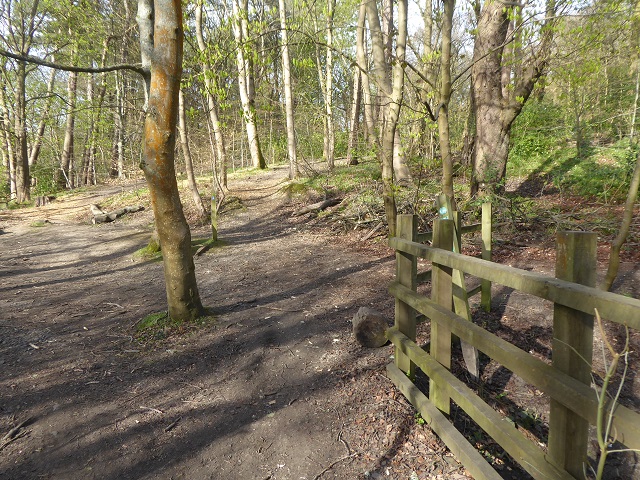
The mountain bike trails are similarly quiet. There is plenty of space to avoid bikes and I have found those biking unfailingly polite, with people stopping or veering off to let me past even though on formal trails like this I believe it should be up to others to step aside.
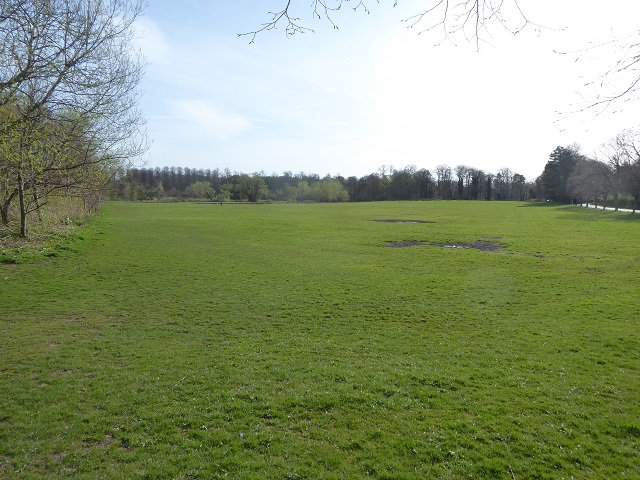
I have NEVER seen more than half a dozen people on this space (some boggy sections in middle). Early last week I ran past a couple with a baby sitting in the grass enjoying the sun the only people in this large area. Under the regulations they were committing a crime. I believe they were doing the right thing and the shame is that so many young families who might have benefitted from being outdoors have been frightened into staying indoors.

On the main thoroughfares through the Park, there is plenty of space for people to pass despite the laybys – which could have offered even more space – being blocked off. I am sure there are more people earlier in the day, that sometimes this road is busier, but the point is there is lots of space to keep 2m apart.

There are only two places in the whole of the Park where I have found any difficulty in keeping 2m apart from others. One is by a path round the Stable Block, the other pictured above, is where the path runs between two hedges for 60m or so . These have barbed wire fences running through them, making it difficult to step aside and it’s difficult to see ahead. I have come across people on this stretch a couple of times, we have turned our heads and stepped into the hedge. To me, that is an acceptable solution that I am sure other people are applying to constricted paths in the countryside. I guess the government, if it has bothered to think about the issues, must believe so too, otherwise they should have done something to help people to manage the risks.
If public health – who have been completely sidelined in this crisis – thought the risk was unacceptable, there are always solutions. In this case you could make this section of path one way and, for anyone returning, could divert them along the golf course that lies on the other side of the left hand hedge. That, however, would require our public authorities to take a pro-active role. Unfortunately, our countryside management teams, just like the NHS, have been slashed under austerity. There are far far fewer people working at Pollok Park than in the past.
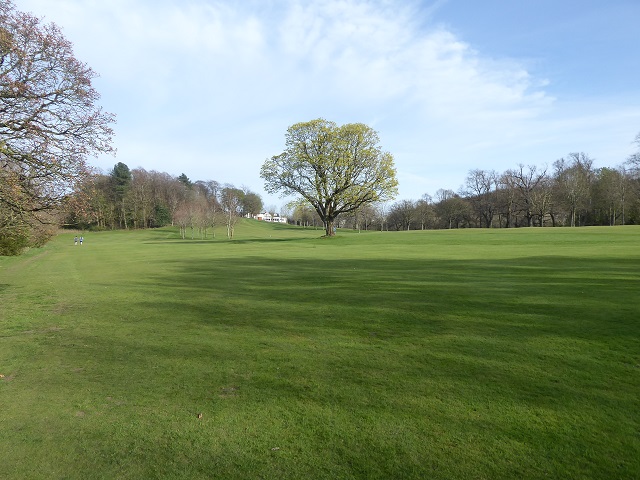
On the golf course – where access rights apply – just beyond the narrow section of path, there is even more space. Golf is one of the few organised sports where it should be very easy to maintain social distancing yet rather than trust golf clubs to ensure this happens – they could keep club houses closed etc – they have been shut down. I don’t believe that was necessary but, having shut them down, that creates more space in urban areas for people to walk. So, why try and limit people to an hour?
Impact of government measures on use of Pollok Park
While Glasgow has lots of green space, Pollok Park and its environs is the largest open space in the city and should have been playing a key role in enabling people to go outdoors while observing physical distancing during the corona crisis.
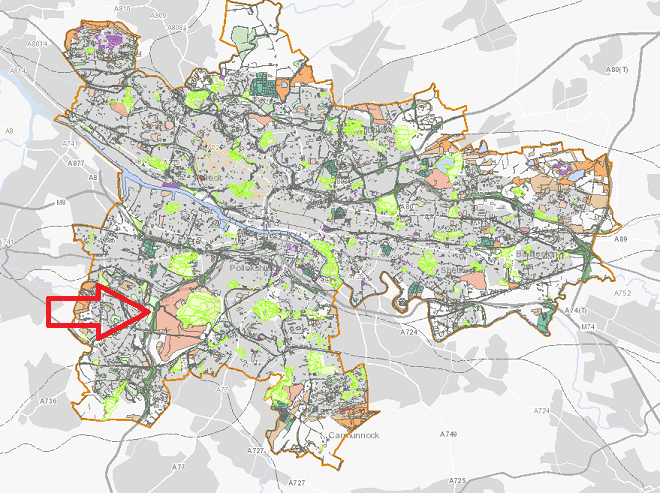
Yet, both the Scottish Government government and Glasgow City Council have been making it harder for people to get to the Park.
The latest Scottish Government utterances that people shouldn’t drive to take exercise and should limit exercise to one hour, has made it increasingly difficult for people to get to the Park. I live a mile and a bit away and can run there in about 12 minutes (you can tell how slow I am getting!) through rich and spacious West Pollokshields. If you have a young family and stay where I do, it would be quite challenging to get to the Park within half an hour by foot. By which time, according to the Scottish Government, the responsible thing is to turn back. I think that’s nonsense.
Its also deeply discriminatory. Pollok Park is partly cut off by motorway – remember the Free Pollok State protests against the M77 which cut the Park off from working class communities? The main group of people who can easily the Park on foot live in leafy West Pollokshields and after that come people from Shawlands. So, the biggest space in Glasgow is mainly accessible to the richer half of the population. It would be worth further study, but the people who have most need to get out, those who lives in tenements and flats without gardens, appear to be being forced by the government’s guidance into the smallest greenspace. So much for social justice.
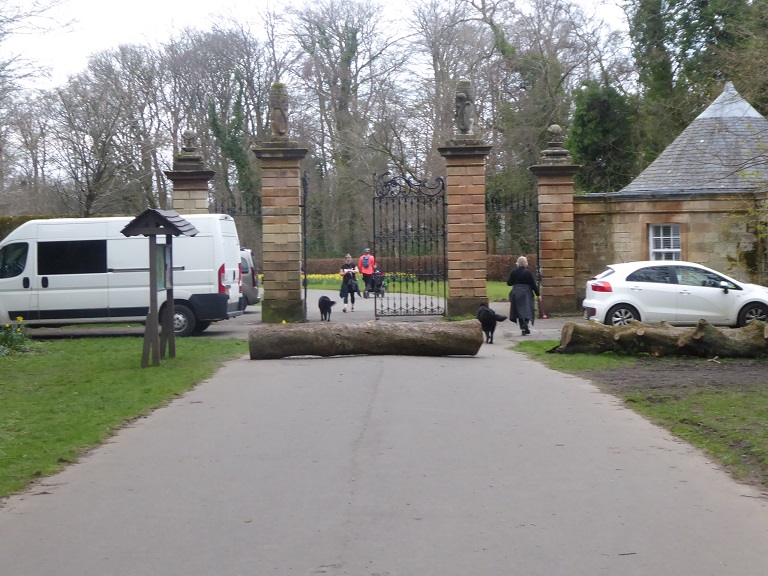
While the Scottish Government has been ramping up its exhortations not to go out, Glasgow City Council gradually shut down the Park to cars. After shutting down the main car parks – which had been far less crowded than usual – it has made extraordinary efforts to block off entrances (see above) and laybys.
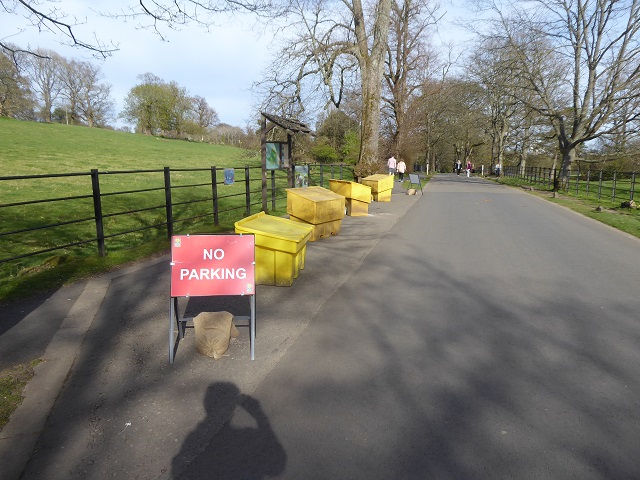
Had this been done to provide MORE space for people to walk safely – because cars do force people onto the side of the road – or indeed to reduce traffic pollution (now there’s a thought!) I might have had some sympathy. But, actually what the closure to the Park to vehicles has done is to deprive people who are unable to walk or bike from being able to enjoy the largest and safest open space in Glasgow. So, the situation in the city mirrors what has been happening in the countryside.
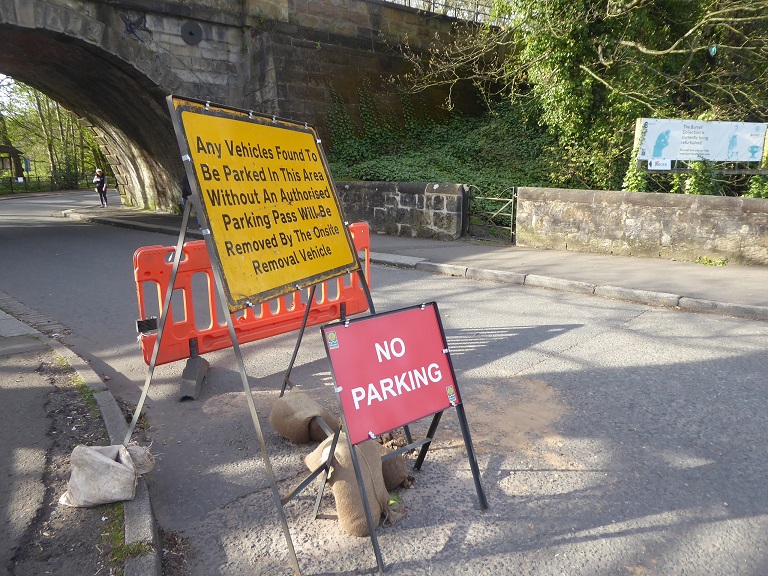
Instead of using its resources to HELP people get outdoors safely, the Council appears to be employing someone specifically to watch out for any vehicle that dares pass the barriers and tow it away.
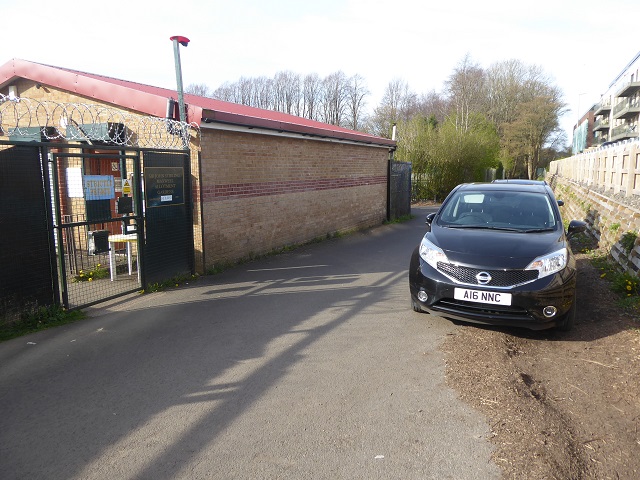
Having banned cars, however, the Council then appears to have exempted allotment holders. Its hard of conceive of any possible justification of why its safe to drive to an allotment but not safe to drive to the rest of the Park (or the wider countryside). Moreover, if its safe for people to spend more than an hour in an allotment, which I believe it is – even though you may be sharing certain facilities like water taps with others – then what is the justification for limiting the time people can spend in Parks or the wider countryside?
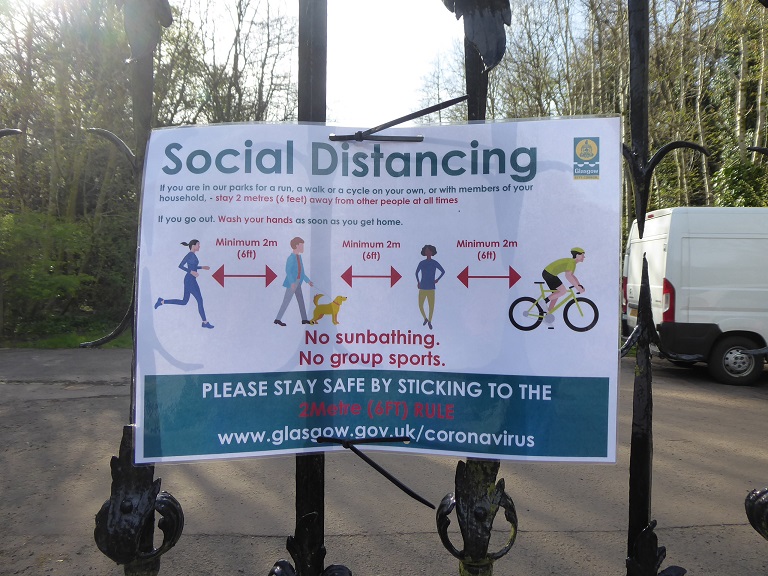
The diagram on this sign is very helpful, it’s focuses on the key issue and mercifully doesn’t tell people to get out the Park after an hour. I don’t think we should call it “social distancing”, however, its physical distancing. People should be allowed to stop and talk as long as they are keep their PHYSICAL distance.
But why then pick on sunbathing rather than all the other activities that DON’T involve physical exercise? If you think about it, you are even less likely to be sneezed on someone lying on the grass than you would from someone walking or cycling past. (Indeed, us runners have been accused of being a danger because of spluttering). Passing 2m by someone who is horizontal poses even fewer risk than passing 2m by someone who is vertical. So, why ban sunbathing when there is so much empty space? Why too when we know that the Vitamin D you get from the sun plays an important role in boosting immune systems (see here) and lack of it is associated with Scotland having the highest rates of Multiple Sclerosis in the world? Another example, to join a long list, of the adverse consequences of the Stay at Home message.
Technically, of course, the Council is right, sunbathing is against the law but that makes the law disproprortionate and an unjustifiable curtailment of civil liberties.
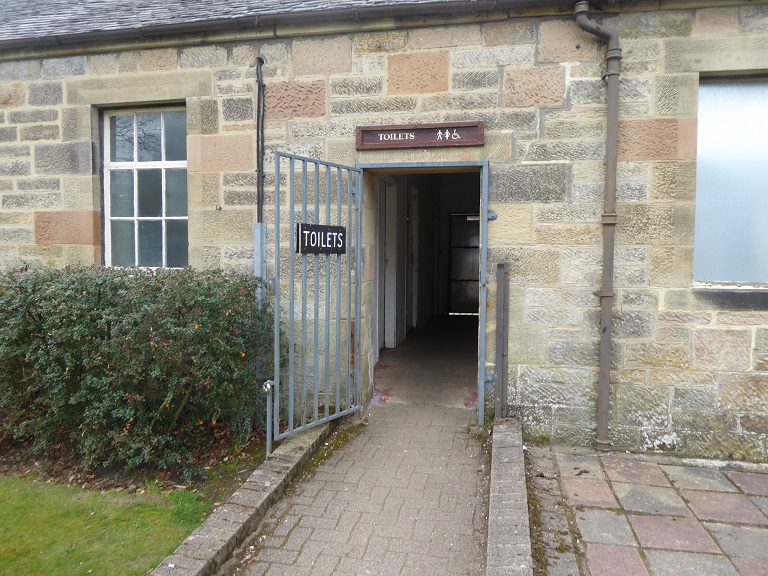
The Council, however, has done one thing right, its left the remaining public toilets – those at the Burrell are closed – open.
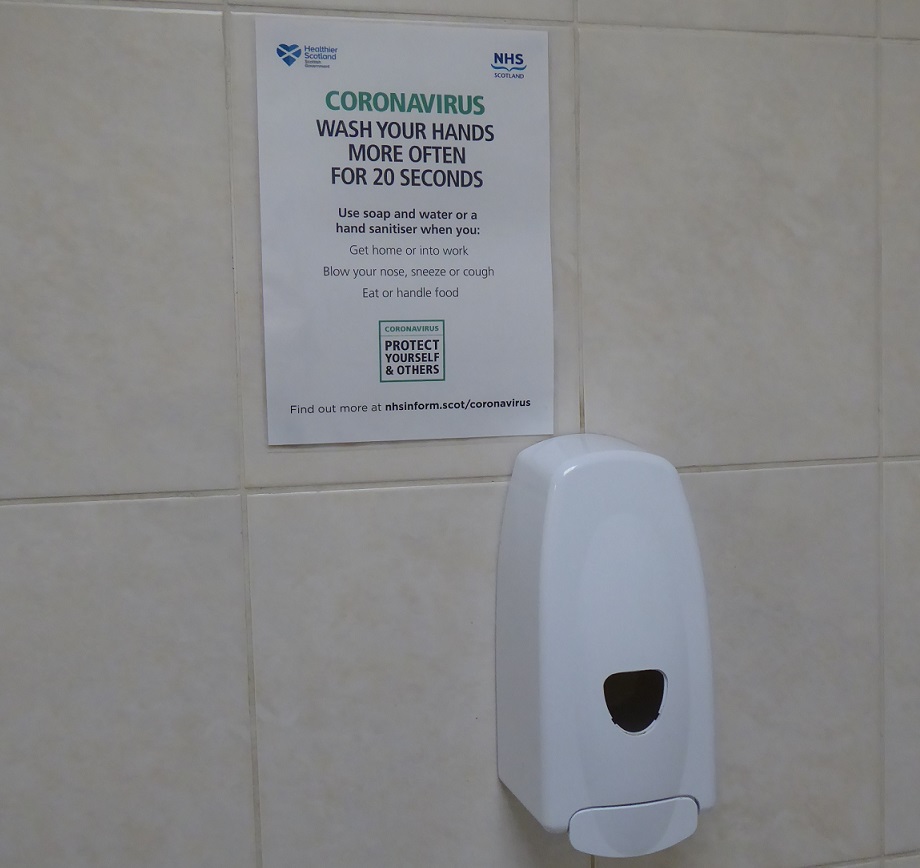
What’s more, the toilets are clean, there is lots of soap and hot water and a very helpful message. Just what our Public Authorities should be doing. What a contrast to the Loch Lomond and Trossachs National Park Authority, which closed all its toilets even before the lockdown, and to Councils like Argyll and Bute that have done the same. Whoever is responsible deserves to be congratulated.
What can we learn from Pollok Park?
Unfortunately, I don’t believe the Scottish Government has paid any attention to how open space might be used to support people during the corona crisis. The result is that people are being confined to their homes unnecessarily, with all the adverse consequences that has (mental well-being, strain on relationships, domestic violence, alcohol and drug abuse etc etc). These adverse consequences are the opposite of all the benefits that are listed in the many government policy documents extolling the virtues of physical activity and open spaces.
I can understand the Scottish Government has greater priorities (like personal protective equipment, getting support to people without income) than dealing with outdoor recreation, but the answer to that, surely, is instead of following London and trying to manage everything centrally, is that we should be delegating and devolving decision making. All the government needs to do is change the regulations to allow people to leave their homes for their mental well-being as for physical exercise and then to set out some rules about travel ((see here for developments in England, the subject of a future post) and it could then leave any management issues to our Local Authorities and our National Parks. It will need to do that eventually anyway.
Today has been beautiful and sunny and I suspect that Pollok Park will have been relatively crowded (I am about to go out). While I know there is a lot of space in the Park as a whole, just like there is in the countryside in Scotland, there may have been some pressure points. We need our public authorities to address those pressure points, whether in urban parks or the countryside. It shouldn’t be difficult. Councils that employ rangers might not even need to put them on site. A few signs pointing people to alternatives if it looks like physical distancing might be an issue, would in most cases be enough.
My experience is that those venturing out are being responsible and, like me, have no wish to pass on the virus. It’s time government respected that and started to facilitate people getting out, whether within in our towns or our countryside, rather than trying to restrict this. The more spaces open to people to visit, the easier it is for people to keep their physical distance.

Nick, a constructive and well argued post as usual. It’s a pity that more people don’t think about the implications of lockdown. For instance, I have two relatives at present living together because one was visiting the other when the lockdown was announced. One is almost 90y.o. and the other is one of the 1.5m most at risk! They do not agree that the lockdown restrictions need to be rethought and even eased. The government is trying to get to 100k covid tests per week by the end of this month. That means to test every man, woman and child in this country will take just under 660 days, almost two years! Last week it was suggested by someone in Public Health that we should be doing 1,000,000 tests per week, which is still almost 66 weeks. Can you imagine the physical and mental effects of lockdown for that period of time, IT CAN’T HAPPEN. It has been announced that we should have a vacccine in about 12 months. Not quite 66 weeks but for the same reasons IT CAN’T HAPPEN. Sooner or later the governments have to relax the rules. In fact it may already be happening. Tonight on the BBC Downing Street briefing it was revealed that councils are being told to unlock the park gates and allow people back in, hopefully with details about social distancing, or, as you so rightly call it, PHYSICAL DISTANCING and how to practice that safely with either spray cleaners fastened to objects that people will touch or wardens, voluntary or otherwise, to clean those areas. Domestic abuse charities are already saying that phone calls to them have doubled since lockdown was applied. How long before the first death by domestic abuse is recorded? Mental health charities are also recording higher volumes of calls. How long before the suicide rate noticeably increases? Governments need to get the lockdown regulations sorted now, not in three weeks, or three months time, before it becomes more of a problem than the virus it is supposed to be protecting us from.
A long and complete post, Nick, which serves to prove what we all know … the laws, as currently enacted, are simply a load of Polloks! So long as we have a reasonable constabulary, with a common sense approach to the real dangers, wheree they accur, it’s not too much of a problem since it does at least make it easier to deal with the persistent dangerous idiots out there, but the next ‘review’ needs to be more than just a rubber stamp.
Thank you Nick. I’ve also been writing (almost finished ) a very similar blog post, from the perspective of someone with PTSD related anxiety. I have had all my strategies to deal with it gradually removed, including cycling and sitting doing my botanical artwork for my diploma. What I’ve been given in return is helplines, that are overrun with callers and not that useful for us with existing mental illness (mental health is not the same as mental illness). I have friends who are borderline suicidal as they’ve had limited access to councillors and are struggling to get medication.
Here on Orkney it’s been taken to the extreme, with police and CAB putting posters on Facebook to share saying it’s the public’s responsibility as part of SOAC to stay away and be responsible. Landowners have closed of paths so people can’t go on local walks and council and msp here both see this as legitimate activity. It’s in turn made every local Facebook group into a snoopers group because some people have nothing better to do.
I’ve now given up writing to my LibDem msp, it’s a complete waste of energy. The liberal democrats, apparently only do liberal when it’s easy.
Thoughtful and well-argued as always. The truth, of course, is that we have been gripped by fear and that many of our public bodies and charities have then acted in haste and are too tardy in taking more rational response. The closure of the coast path in Wales is my particular and local bugbear, but all the same issues apply as in your post. That today there would need to be directive instructing English councils to open parks is a disgrace.
Two tangential thoughts:
Every night the two UK newspaper wholesalers Smiths News and Menzies Distribution (the industry I have spent my career in) are continuing to deliver newspapers in incredibly tight timetables to circa 40,000 retailers across the country. They have no option to delay or deliver later (nobody wants yesterday’s news) so they have put in place appropriate measures, got on with the job, and done it magnificently, if not without some difficulty. But here’s the thing: their staff (circ 6,000) are not falling over the with the virus – and we don’t see news reports of how there are dozens of logistics drivers are dying with the virus – and that’s because the risk of contagion in these sorts of environments is quite low – not zero, but relatively low. The same must be surely true of open spaces.
Second thought – when we do lift the restrictions (as will happen when many parks open and I suspect later this spring/summer for areas like Snowdonia ) unless I’m missing something the risks will actually be higher – still minuscule, but actually higher! For example, when the Pembroke coast path was closed infection rates in the area were at rate of 12 reported cases for a population of circa 400K – they now stand at nearly 500 cases and rising. So how will waiting for the so-called ‘peak’ to pass make it safer? It won’t will it – or am I missing something? My point is that if its okay to open the paths and spaces later, why should they not be open now? For many people, this may seem academic – they can’t get out to the hills and coast anyway – but for those who live next door or nearby it is ridiculous that these facilities are not available.
Sorry I go on – but to give but one example, the town of Fishguard has around 10,000 inhabitants, minimal parks and limited places to walk, other than a magnificent, deserted and (virus wise) almost totally safe coast path – which is closed!
Good work Nick
I can’t work out I can’t go kayaking in a country like Scotland which is under populated but I am made to walk on a public pavement which is now over populated by joggers bikes dog walking people wee are all being pushed together and you can order a take away this will involve 5 people 4 in the kch and a driver were are the police I can’t get a hair cut but I noted your MP Sturgon is well groomed and the press all need hair cuts
Small update – yesterday 20 April – the Wales govt. declined to breakdown the number of deaths outside of the urban south because to do so could identify the individuals involved!! It was however confirmed that there were only 13 deaths across the whole of West, Mid and North Wales. That’s an area the size of the entire Home Counties. And yet the lockdown here is just as total. This is absolute madness. Regardless of the access issues that mainly concern us here – economically it is having a devastating effect on a region that is not well placed to recover. Why shut down every supposedly non-essential business in Milford, Pembroke, Fishguard, Bangor, Carmarthen, Wrexham… ? Surely it’s not beyond us to have some intelligent subtlety in the way we respond to this issue by region.
It is indeed Mark. Except, as Professor Alison Pollock from Newcastle has pointed out (I think I have her ideas correct), we should have started with local responses. But we have disempowered local and regional government in the UK. I do believe Shetland closed its schools before anywhere else due to local circumstance. But really, if it had been done area by area, London would have been locked down first. The virus travels from continent to continent by air travel, and many people arriving in the UK land at a London airport,travel through the city itself, and onwards to the four corners of the UK. And they are still doing it! But to apply regional and local solutions to a relaxation of lockdown now would, I think, be politically difficult. I know we are not really all in it together, but TV pix of happy rural dwellers enjoying the sunshine and going to the pub will not go down well in inner city high rise and tenements. Last word; test and trace.
Nick, another very useful analysis of the lockdown situation. But is it really true that you are breaking the law? The restrictions on movement in the Scottish regulations are in effect the same as the English regulations, though the Scottish wording is a bit more obscure. But in both cases they relate only to leaving the place where you live – provided you leave for a valid reason there is no restriction in the regulations on what you do after leaving. Guidance to the Police in England (based on guidelines issued by the Crown Prosecution Service) now allows people to drive to where they take their exercise and to stop to rest or eat lunch while on a long walk – the test seems to be proportionality, if the main thing your are doing is satisfying a need for exercise then it was reasonable for you to leave home. If you are mainly doing something else, end just throw in a bit of exercise, then it would be interpreted that you did not leave home because of the need for exercise. See https://www.bbc.co.uk/news/uk-england-52312560.
Note that the list of “reasonable excuses” for leaving home given in the regulations is not exhaustive, presumably if you can think of another reasonable excuse in the circumstances (as you have done, mental well-being and sense of community), that should also be regarded as an acceptable reason to leave home.
Roger
I have no legal background – it would be great if someone with expertise in Scottish Law could comment. For the benefit of those that have been confused by constant repetition of advice as if it were the law, I have given an extract of the relevant clauses of the Scottish regulations, which can be downloaded in full at the link below.
Regulations in Scotland: See http://www.legislation.gov.uk/ssi/2020/103/pdfs/ssi_20200103_en.pdf
S C O T T I S H S T A T U T O R Y I N S T R U M E N T S
2020 No. 103
PUBLIC HEALTH
The Health Protection (Coronavirus) (Restrictions) (Scotland)
Regulations 2020
Made – – – – at 7.15 p.m. on 26th March 2020
Laid before the Scottish Parliament 27th March 2020
Restrictions on movement
5.—(1) Except to the extent that a defence would be available under regulation 8(4), during the emergency period, no person may leave the place where they are living.
8.(4) It is a defence to a charge of committing an offence under paragraph (1), (2) or (3) to show
that the person, in the circumstances, had a reasonable excuse.
(5) In paragraph (4), a reasonable excuse includes the need—
(a) to obtain basic necessities, including food and medical supplies for those in the same
household (including any pets or animals in the household) or for a vulnerable person and
supplies for the essential upkeep, maintenance and functioning of the household or the
household of a vulnerable person, or to obtain money,
(b) to take exercise, either alone or with other members of their household,
(c) …
Hi Roger, this is very interesting but I am not sure you are right about the meaning of the regs. “No person may leave where they are living” can either be read as referring to “the act of leaving” – which is what you are suggesting – or “that no person may be away from where they are living ” in which case any conditions apply as long as you are away. In other words you couldn’t go out for exercise and then regain your freedom to do what you wanted. While this would be up to the Courts I think they would say the intention of the government was clear, they wanted to keep people in their houses. Where I think there is more legal leeway is in what is a reasonable excuse for leaving your home, the list as the regulations make clear it is NOT exhaustive. It will be interesting to see what happens if someone refuses a Fixed Penalty Notice and asks the courts to decide whether being sitting in the sun is a reasonable excuse for being outside or not. Its quite clear, however, that the Scottish Government doesn’t see this as a reasonable excuse (as I will touch on in post coming out later). It also appears that the interpretation and of the law so far in Scotland has been much narrower and the application more draconian than in England where, as you say, guidance is that in exercising your right to go out for physical excercise its quite reasonable to drive to the place you want to exercise. More about this in post I am working on now……………….Nick
Hi Roger it turns out the Home Office thought you were right and tried close loophole in English Regs only to create more! Seehere
The phrase “leave the place where they are living” is also used in the English regulations, and to me clearly refers to the act of leaving – if they had meant “be away from where they are living” they would have said this. I will ask a (Scottish) solicitor friend if she can clarify the law.
I was looking into the regulations for a different reason: we run a “secure dog walking field” in North East Scotland where people can book a time slot for their exclusive use and let their dogs off lead within a 6 acres securely fenced enclosure. It’s intended for dogs that can’t otherwise be let off-lead (chase livestock, reactive to other dogs, nervous of people or dogs, recall training, etc.) but now people are also finding it a very safe place to walk their dogs, they are guaranteed not to meet anyone else. The Police contacted us after a complaint and said we should close as we were not an essential business and were putting people in danger of passing on infections. I told them that on the contrary we provide a safe place for people to take their exercise, and we weren’t on the list of businesses that must close. They told me that they would rather we closed, but we weren’t infringing the current regulations so they couldn’t force us to close. We have some NHS workers using the field, and one man on chemotherapy after an operation for cancer, who all feel that this is one place where it is safe for them to exercise. Many other secure dog walking fields have remained open. Some people have questioned whether it is allowed for people to drive to the field, in England this has been clarified here: https://www.facebook.com/privatedogwalks/posts/2268213866806897, and I would expect the same would apply in Scotland given that the relevant regulations are essentially the same.
Roger
Hi Roger, a brilliant example of the government in its widest sense taking an overly draconian approach to the shut down of the countryside. There is no reason why almost all outdoor businesses should not continue at present. Would be interested to hear what the Scottish solicitor says but I am not sure you are right about the intentions. The UK Government Guidance states: “These reasons are exceptions – even when doing these activities, you should be minimising time spent outside of the home and ensuring you are 2 metres apart from anyone outside of your household.” One of the problems is that dog walking is not even listed as one of the reasonable excuses for being out the house – which shows just how badly these laws have been thought through. Nick
Re physical distancing :- I would hazard a guess that Nicola Sturgeon ( amongst many, many others) reads your Blogs, Nick. Today Scottish Government published a document : Publication- Strategy/ Plan. Coronavirus (Covid-19): framework for decision making : http://www.gov.scot/publications/coronavirus-covid-19-framework-decision-making/pages/2/ On the first page under Our Approach and Principles the first bullet point states “Suppress … physical distancing and … “ . I believe this is the first time this term has been used by anyone other than yourself, and especially not by anyone in Government or the Press!
Golf: it may be possible to maintain safe distance from other golfers but there’s more to it than that.
* flags will be handled by multiple people, creating an infection risk (although they could be removed)
* each time someone collects a ball from the hole they’ll touch the plastic cup
* areas with highest visitor density (greens & tees) could repeatedly be sprayed with showers of droplets, possibly creating a risk of contamination picked up on footwear?
Well Noel its just a few weeks since Professor Jason Leitch was saying on the radio – sorry I didn’t keep the link – that golf was safe so long as people took care with the flags. I suspect the risks you have identified were very very low even when the Covid 19 outbreak was at its height in the community. Those levels have now dropped dramatically due to physical distancing. In my view government needs to start differentiating activities and places where risks are very low from activities and places where risks are very high – golf courses fall into the former category, care homes in the latter. I believe government should be focussing its attention on controlling the medium to high risk areas and letting people take their own decisions about whether to take part in low risk activities like golf (not that golfing shouldn’t issue advice to golfers about ways of picking your ball out of a hole that minimises risks. I would have thought carry a hand sanitiser would do the trick.
And a good sharp blade to cut your hand off on the slight chance you run out of sanitizer